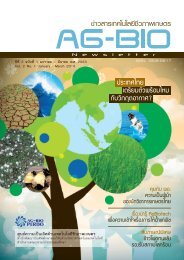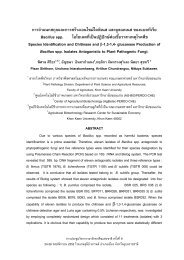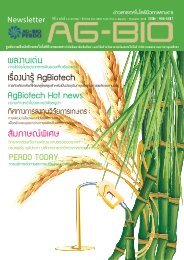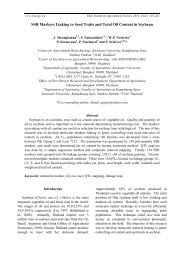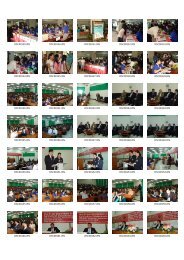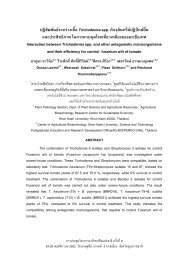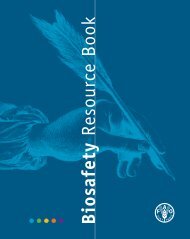Biosafety Manual PDF - Lawrence Berkeley National Laboratory
Biosafety Manual PDF - Lawrence Berkeley National Laboratory
Biosafety Manual PDF - Lawrence Berkeley National Laboratory
You also want an ePaper? Increase the reach of your titles
YUMPU automatically turns print PDFs into web optimized ePapers that Google loves.
<strong>Biosafety</strong> <strong>Manual</strong><br />
IBC-approved version (May 18, 2010)<br />
• Bloodborne pathogen (BBP) materials (e.g., human blood, human tissues, or human<br />
cells);<br />
• nonhuman primate tissues or cells;<br />
• viral vectors that are replication defective but still infectious to human cells;<br />
• laboratory animals (e.g., rodents) infected with, implanted with, or containing RG2<br />
agents or materials (e.g., infected with a human pathogen or containing a xenotransplant<br />
of human cells); and<br />
• tissues or cells potentially containing an RG2 agent (e.g., cells transformed with a RG2<br />
virus).<br />
4.4.2 Additional Containment Categories<br />
Additional types of containment specified in the NIH Guidelines or BMBL may also be applicable<br />
to work with biological materials at LBNL. Table 9 below lists these additional containment<br />
categories and relevant NIH Guidelines or BMBL section. When selecting a containment level<br />
for a type of work listed in Table 9, the supervisor, work lead, and IBC should carefully review<br />
this table to determine if the containment category and criteria apply to the planned LBNL work.<br />
<strong>Laboratory</strong>- or operation-specific authorizations, biosafety manuals, or other documents may be<br />
used to document the containment requirements related to the work. If the containment<br />
categories or criteria presented in Table 9 are not applicable to the work, the laboratory BLs<br />
presented in Section 4.4.1 of this manual are applied.<br />
4.4.2.1 Recombinant Large-Scale Containment Levels<br />
Physical containment guidelines from Appendix K of the NIH Guidelines must be used for largescale<br />
research or production activities involving viable organisms containing recombinant DNA<br />
molecules. Large scale (BL–Large Scale) is a term used in the NIH Guidelines and the LBNL<br />
biosafety policy to describe uses of and containment levels for organisms containing<br />
recombinant DNA molecules involving a quantity of culture greater than 10 liters. Note that this<br />
quantity category typically means the quantity of a material in a single batch of liquid culture;<br />
however, this batch quantity is not defined by NIH and should be used as a guideline to<br />
determine the applicability of large-scale containment criteria. Criteria for large-scale<br />
containment address the biological hazard associated with organisms containing recombinant<br />
DNA only. Large-scale containment criteria must be selected based on the findings of the risk<br />
assessment, and then documented in the <strong>Biosafety</strong> Work Authorization.<br />
4.4.2.2 Recombinant Plant Containment Levels<br />
<strong>Biosafety</strong> containment levels and criteria for recombinant research with plants must be selected<br />
based on the findings of the risk assessment, and then documented in the <strong>Biosafety</strong> Work<br />
Authorization. <strong>Laboratory</strong> or plant biosafety containment levels must be applied to the work as<br />
follows:<br />
• <strong>Laboratory</strong> BLs and criteria discussed in Section 4.4.1 of this manual and Appendix G of<br />
the NIH Guidelines should be used when the research plants are of a size, number, or<br />
have growth requirements that allow good containment when using laboratory BLs.<br />
• Plant BLs (BL-P) must be used when the research plants are of a size, number, or have<br />
growth requirements that preclude the use of laboratory BLs. For plant BLs and criteria,<br />
see Appendix P (Physical and Biological Containment for Recombinant DNA Research<br />
Involving Plants) of the NIH Guidelines.<br />
Printed copies are not official versions of this manual. Before using the printed copy, verify that it is the most current version.<br />
36



